Introduction: Why Fix Burn Hole on Couch Matters
A couch is often the centerpiece of a living room, a place where families gather, friends relax, and countless memories are made. Unfortunately, accidents happen—whether from a dropped cigarette, stray candle ember, or a mishap with a hot tool, burn holes can leave your furniture looking unsightly and neglected. Learning how to fix burn hole on couch not only saves you from the expense of professional repairs or replacement but also helps extend the life of your furniture while maintaining the comfort and beauty of your home.
What makes burn holes particularly frustrating is how small damage can instantly draw the eye, ruining the overall appeal of your seating area. Many homeowners believe such blemishes mean the end of their couch’s lifespan, but that’s not true. With a few simple materials and step-by-step guidance, anyone can confidently fix burn hole on couch at home. Even better, doing so promotes sustainability by reducing waste and cutting down on unnecessary replacements, which is especially important if you’re conscious about eco-friendly living.
This guide walks you through everything you need to know—from preparation and gathering materials to detailed repair techniques. You’ll also discover expert tips, common mistakes to avoid, and alternative approaches if one method doesn’t suit your situation. By the end, you’ll be fully equipped to fix burn hole on couch like a pro and restore your living space to its welcoming, stylish best.
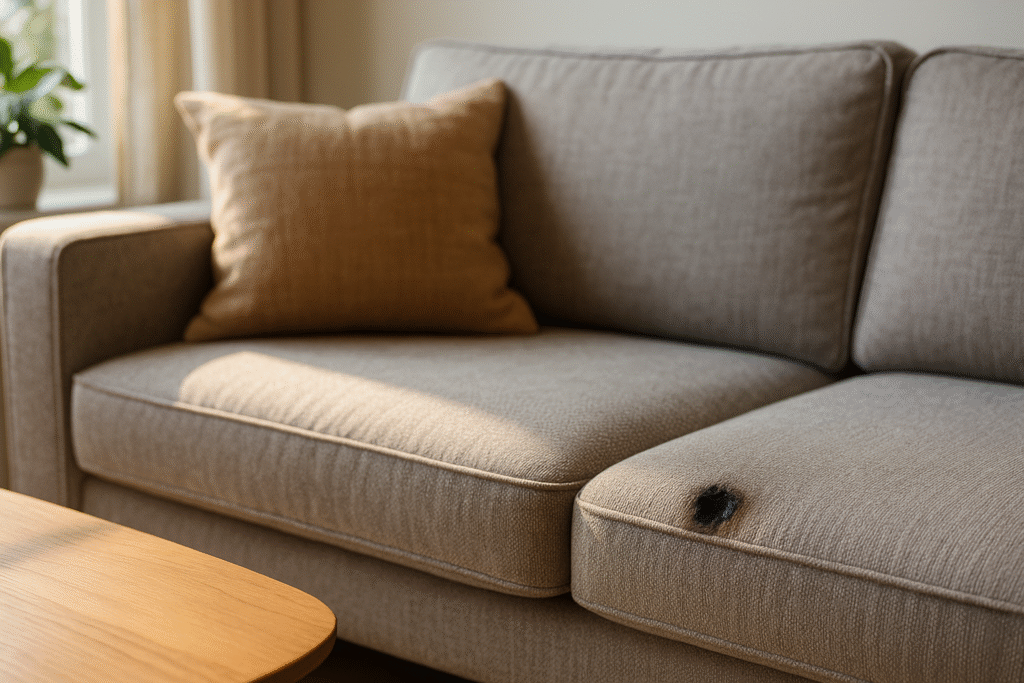
What You’ll Need Before You Start
Before you begin the process to fix burn hole on couch, it’s important to gather the right tools and materials. Preparation not only saves time but also ensures that your repair looks seamless and lasts for the long term. Too often, people rush into fixing damage without the proper setup, which leads to patchy results or further harm to the upholstery. By organizing everything in advance, you’ll make the repair more efficient and stress-free.
The first item you’ll need is a small piece of matching fabric. If you have remnants from when the couch was originally purchased, that’s ideal. If not, you can discreetly cut fabric from an inconspicuous area, such as the back or underneath the couch. In cases where an exact match isn’t available, consider visiting a local upholstery shop for swatches that closely resemble your couch material. Having the right patch is the cornerstone of any successful attempt to fix burn hole on couch.
Next, you’ll require fabric glue or upholstery adhesive. This specialized adhesive is designed to bond tightly while remaining flexible, ensuring your repair doesn’t stiffen or peel over time. For larger burn holes, fabric filler or a small foam insert may be necessary to provide structure before applying the patch. Sharp scissors are also essential for cutting clean fabric edges, while a pair of tweezers will help handle smaller pieces with precision.
Don’t overlook the importance of cleaning supplies. A mild detergent solution or upholstery cleaner should be used to gently clean the affected area before you begin repairs. Any dirt or oil left on the fabric can weaken the bond and reduce the effectiveness of your patch. Finally, keep a small cloth or sponge handy to wipe away excess adhesive during the process. With these supplies in place, you’ll be ready to confidently fix burn hole on couch and achieve a professional-looking result.
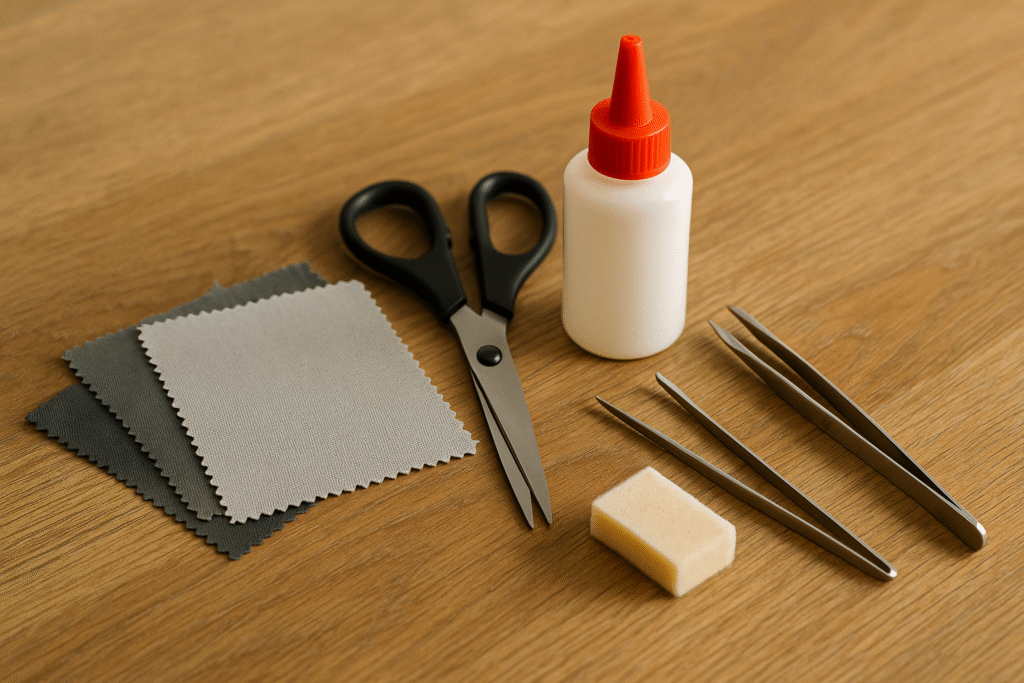
Step 1: Inspect and Prepare the Damaged Area
The first step to successfully fix burn hole on couch is a thorough inspection of the damaged area. Many people underestimate the importance of preparation, but this stage can determine whether your repair blends in naturally or remains a noticeable blemish. Begin by examining the size and depth of the burn hole. Small surface burns that only affect the outer fabric are often easier to handle, while deeper holes may require patching and filler material for support. Take note of any discoloration around the hole, as you may need to trim or clean beyond the immediate damage to achieve a smooth finish.
Once you’ve assessed the hole, clean the area gently using a mild upholstery cleaner or diluted soap solution. Dirt, dust, or oils can prevent adhesive from sticking properly. Use a soft cloth or sponge to dab—never scrub—the damaged area. Allow the spot to dry completely before moving forward, since moisture can also interfere with the bonding process. Cleaning not only ensures a stronger repair but also helps you see the exact boundaries of the damage more clearly, which is essential as you prepare to fix burn hole on couch.
Next, use a small pair of sharp scissors to carefully trim away frayed threads or scorched edges. This step is crucial because leaving charred fabric can weaken the patch and make the repair less durable. Work slowly and cautiously, removing only the damaged fibers without cutting into healthy fabric. If the burn has hardened the surrounding fibers, gently scrape the stiffened pieces with a fine nail file or sandpaper to create a soft, even surface. This smooth base will give your patch or filler material the best chance to blend seamlessly with the rest of the couch.
Finally, double-check that you have enough working space around the burn hole. If possible, remove any nearby cushions to give yourself better access and prevent glue or filler from accidentally staining other areas. Place a small protective cloth or towel under the damaged spot to shield the underlying cushion or frame. With the damaged area fully cleaned, trimmed, and prepared, you’ve laid the foundation for a successful repair. Taking the time to carefully complete this step ensures that when you continue to fix burn hole on couch, every following action will be smoother and more effective.
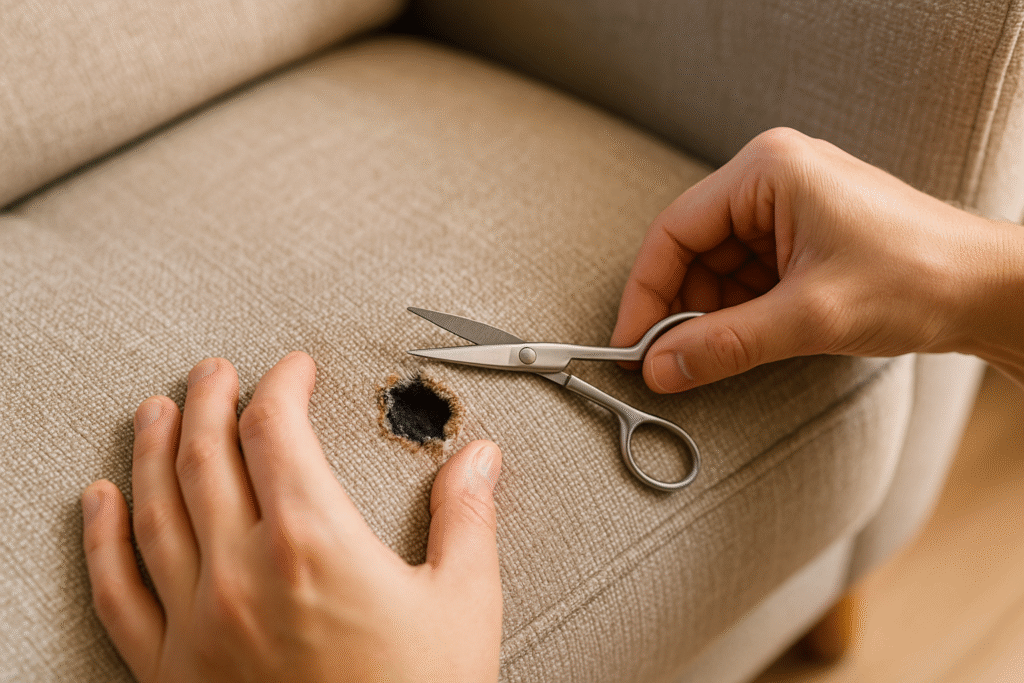
Step 2: Apply Filler or Patch Material
Once the damaged area has been cleaned and prepared, the next step to fix burn hole on couch is filling the gap and restoring the fabric’s structure. The method you choose depends on the size of the burn. For smaller holes—about the size of a pencil eraser—fabric filler is often enough. This pliable material can be pressed into the hole, smoothed over, and blended with the surrounding fibers. It’s especially useful if your couch has a uniform color or tight weave, where the repair won’t stand out. Using a small spatula or even a flat tool like a butter knife, gently press the filler into the burn hole until it sits flush with the cushion surface. Let it dry according to the product’s instructions before moving to the next step.
For larger holes, a fabric patch is typically required. Begin by cutting a piece of matching material slightly larger than the hole itself. It’s always better to cut a patch with rounded edges rather than sharp corners, as this reduces the risk of peeling later. Apply a thin layer of upholstery adhesive to the underside of the patch and carefully position it over the damaged area. Press firmly with your fingers or a flat tool, making sure all edges are securely bonded. Some adhesives may require light pressure for several minutes, so place a clean cloth over the patch and weigh it down with a small object if necessary. This ensures the patch integrates seamlessly as you fix burn hole on couch.
If the burn hole extends deeper into the cushion, you might need to insert a small piece of foam beneath the patch for added support. Cut the foam to size and tuck it under the damaged area before applying the fabric patch. This prevents sagging and keeps the cushion surface level. Once the foam is in place, apply adhesive and patch as described above. As you work, always remove any excess glue with a damp cloth to avoid leaving behind shiny spots or stiff edges. Patience here makes all the difference between a patch that blends naturally and one that looks like an obvious repair.
After the patch or filler has been applied, allow ample drying time. Rushing this step is one of the most common mistakes people make when they fix burn hole on couch. Follow the drying instructions carefully, and resist the urge to test the repair too soon. When done correctly, the patched area should feel secure, smooth, and well-integrated into the fabric. By giving the materials time to set, you ensure that your repair will not only look better but also last longer, saving you from having to repeat the process later.
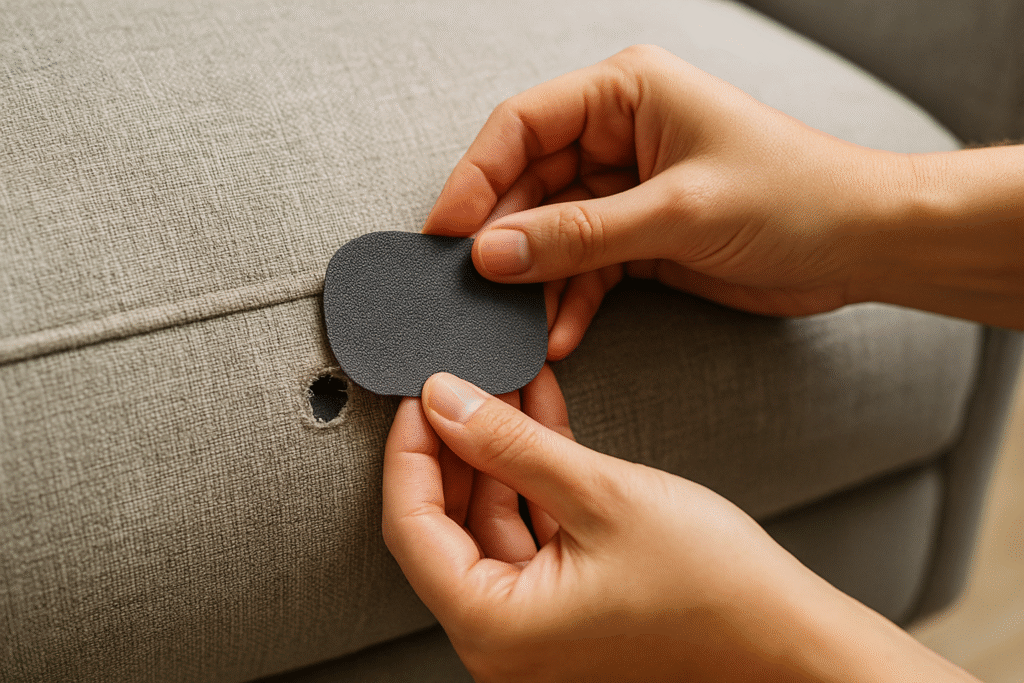
Step 3: Blend and Finish the Repair
After applying filler or a patch, the final stage to fix burn hole on couch is blending the repair so it looks natural and finishing the surface for durability. Even the most carefully applied patch can appear obvious if it isn’t smoothed and color-matched with the surrounding area. Start by gently pressing the repaired spot with a clean cloth to make sure the adhesive has bonded securely. Run your fingers lightly over the area to check for uneven edges or bumps. If you feel any excess filler, carefully trim or sand it down with fine-grit sandpaper until the surface feels level with the rest of the couch. This step helps create a uniform texture that will be easier to disguise during the blending process.
Once the repair is smooth, it’s time to focus on color matching. Upholstery repair kits often include fabric dyes or color pens that allow you to tint the patch so it blends into the couch. Begin by testing the color on a small, hidden area of fabric before applying it directly to the repaired section. Build the color gradually, layering lightly instead of applying too much at once. This way, you can adjust the shade until it nearly disappears into the surrounding fabric. For patterned upholstery, use multiple shades to mimic the texture and variation of the original design. Proper blending is one of the most effective ways to make your effort to fix burn hole on couch look professional.
If your couch has a textured weave, you can recreate the appearance by lightly brushing the surface with a small, stiff-bristled brush. This technique lifts fibers around the patch and helps it integrate visually. Some people also use a fine needle to tease fibers from the patch outward, blending them into the original fabric. While it may sound tedious, these small finishing touches often determine whether your repair looks discreet or stands out. When executed carefully, the blend will be nearly invisible to anyone who sits on or looks at your couch.
Finally, protect the repaired area by allowing it to cure fully before heavy use. Avoid placing pressure or weight on the spot for at least 24 hours, depending on the adhesive and filler used. You may also want to apply a light coat of fabric protector spray once everything is dry, which adds resistance to stains and future wear. By taking the time to finish and protect your repair, you ensure that your decision to fix burn hole on couch pays off in the long term, both in aesthetics and durability. At this point, your couch should look refreshed, comfortable, and ready to reclaim its role as the centerpiece of your living room.
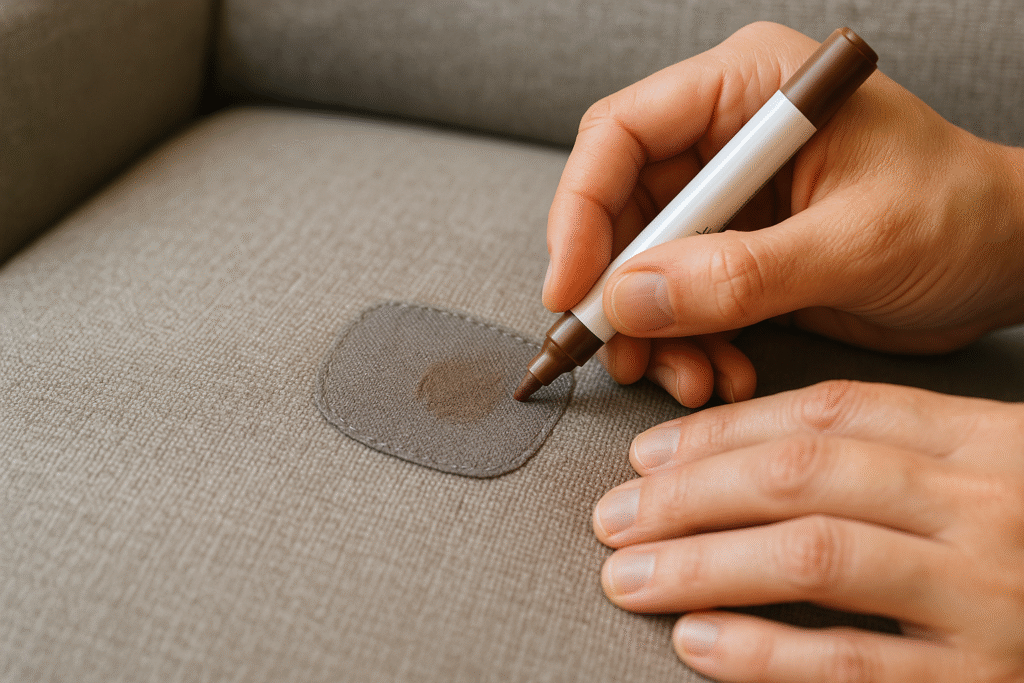
Common Mistakes to Avoid When You Fix Burn Hole on Couch
Attempting to fix burn hole on couch at home can be highly rewarding, but many people make mistakes that compromise the final result. Knowing what to avoid can save you time, frustration, and the expense of having to redo the repair. One of the most frequent errors is rushing through preparation. Skipping the cleaning stage or failing to trim away scorched fibers often leaves behind debris that prevents adhesive from bonding correctly. This oversight can cause your patch to peel off prematurely or leave the surface uneven, making the repair stand out rather than blend in.
Another common mistake is using the wrong adhesive or fabric glue. Not all glues are designed for upholstery; some harden too much, leaving a stiff, shiny surface, while others fail to create a strong bond. Always opt for an upholstery-specific adhesive, and test it on a small hidden area before applying it to the burn hole. Similarly, some DIYers try to fix burn hole on couch using household tapes or generic glues, which rarely deliver a long-lasting result. Investing in the right materials is crucial if you want a seamless and durable finish.
Color mismatch is another pitfall. Even if the patch is cut and applied correctly, failing to blend its shade and texture with the rest of the couch can make the repair glaringly obvious. Always use fabric dye, repair pens, or textured brushes to achieve a natural look. Skipping this step leaves your couch with a visible patch that draws more attention than the original burn hole. Likewise, over-applying color in one go can create blotches, so remember to layer gradually until the repaired area matches the surrounding fabric.
Finally, many people make the mistake of rushing the drying or curing process. Adhesives and fillers require time to bond fully, and using the couch too soon risks damaging your repair. Place a protective cloth over the area if needed, and resist the urge to sit on the couch until the adhesive has completely set. By avoiding these errors—poor preparation, wrong materials, mismatched colors, and impatience—you’ll drastically improve your ability to fix burn hole on couch effectively. In turn, your repair will last longer and maintain the comfort and style of your living space.
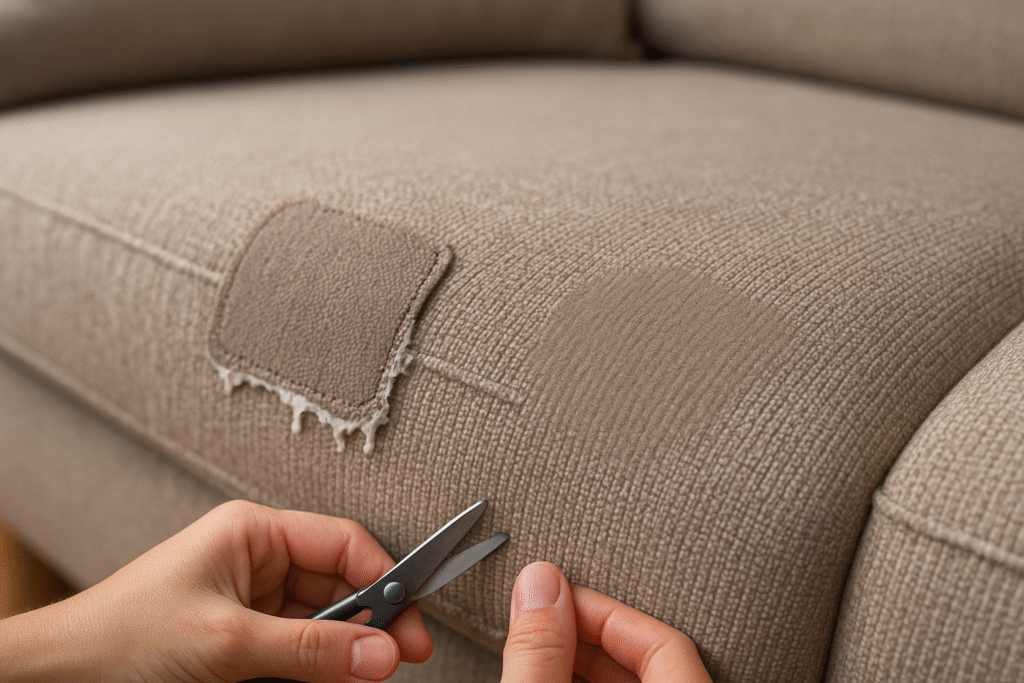
Alternative Methods for Fix Burn Hole on Couch
While the traditional approach of patching or filling is the most common way to fix burn hole on couch, there are several alternative methods that can be just as effective depending on the type of upholstery and the extent of the damage. Exploring these options is helpful if you lack matching fabric, prefer not to use adhesives, or simply want a creative solution that refreshes your furniture. Each method has its pros and cons, so understanding them can help you choose the one that best fits your couch, your budget, and your desired aesthetic outcome.
One popular alternative is fabric embroidery or decorative stitching. Instead of hiding the burn completely, you turn it into a design feature. By stitching a small patch with decorative thread, you can transform the blemish into a unique accent. This method works particularly well on couches with patterned or textured fabric, where a subtle embroidered design feels natural. For a modern look, some homeowners intentionally add multiple decorative patches across their couches, making the repaired area look like part of a custom design rather than a repair attempt to fix burn hole on couch.
Slipcovers offer another practical solution. If your couch has multiple burn marks or you’re struggling to find a perfect fabric match, investing in a fitted slipcover can instantly conceal the damage while giving your living room a fresh, cohesive look. Slipcovers come in various colors, textures, and styles, and many are machine-washable, making them a long-term option for protection and style. Although this method doesn’t technically repair the burn hole, it provides a fast and effective workaround.
For couches made of leather or faux leather, liquid leather kits are a strong alternative. These repair kits typically include a compound that can be colored and smoothed directly into the burn hole. Once dried, the result is flexible and visually similar to the surrounding surface. This method eliminates the need for cutting and patching, and when applied carefully, it can produce nearly invisible repairs. If you’re working with fabric upholstery, however, this method won’t apply, so make sure the kit you purchase matches your couch material.
Finally, if DIY methods don’t feel right, professional upholstery services remain a reliable alternative. Hiring an expert to fix burn hole on couch ensures the repair blends seamlessly and lasts for years. Professionals often have access to advanced tools and matching fabrics that aren’t available to the general public. While this option can be more expensive, it may be worthwhile if your couch is a high-end piece or holds sentimental value. Regardless of the path you choose, knowing these alternatives provides flexibility and helps you find the best way to restore your furniture.
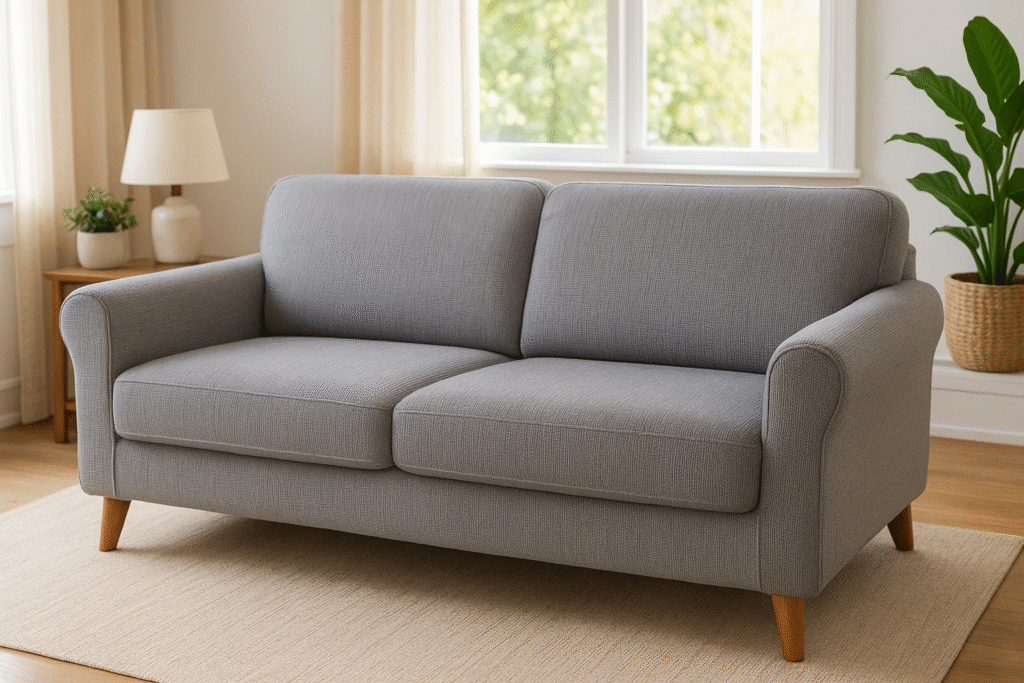
Expert Tips and Best Practices
If you want your attempt to fix burn hole on couch to look professional and last for years, following expert tips can make a huge difference. Professionals emphasize that success isn’t just about applying a patch—it’s about careful preparation, the right choice of materials, and attention to detail. One key practice is to always test products before applying them. Whether it’s fabric glue, filler, or dye, test it on an inconspicuous spot of the couch to make sure it doesn’t discolor the fabric or leave an unwanted residue. A quick test can save you from permanent damage and frustration.
Another best practice is to work in a well-lit environment. Natural lighting allows you to see subtle color variations and ensures that your repair blends more effectively. Dim light often hides flaws during the process, only for them to become obvious later. Experts also recommend layering your approach—apply glue thinly, build color gradually, and smooth filler in stages rather than all at once. This patient, step-by-step method produces far better results than trying to rush through in one go.
For couches with complex patterns, professionals often suggest blending with multiple color repair pens or dyes. This helps replicate the original texture and pattern, especially in fabrics with gradients or weaves. Additionally, don’t neglect protective measures after completing the repair. Applying a fabric protector spray can help prevent future stains, fading, or new burn damage. This small investment adds an extra layer of durability to your work.
If you’re new to upholstery repair, seek inspiration and detailed instructions from trusted sources. The Wikipedia guide on upholstery provides a helpful overview of fabrics, techniques, and maintenance practices. Likewise, many furniture-care organizations share best practices online, and consulting them ensures you’re following proven methods rather than relying on trial and error. Finally, if you ever feel the repair is beyond your skill level, don’t hesitate to consult a professional upholsterer. Experts have access to advanced materials and tools that make repairs nearly invisible, ensuring your effort to fix burn hole on couch is both successful and long-lasting.
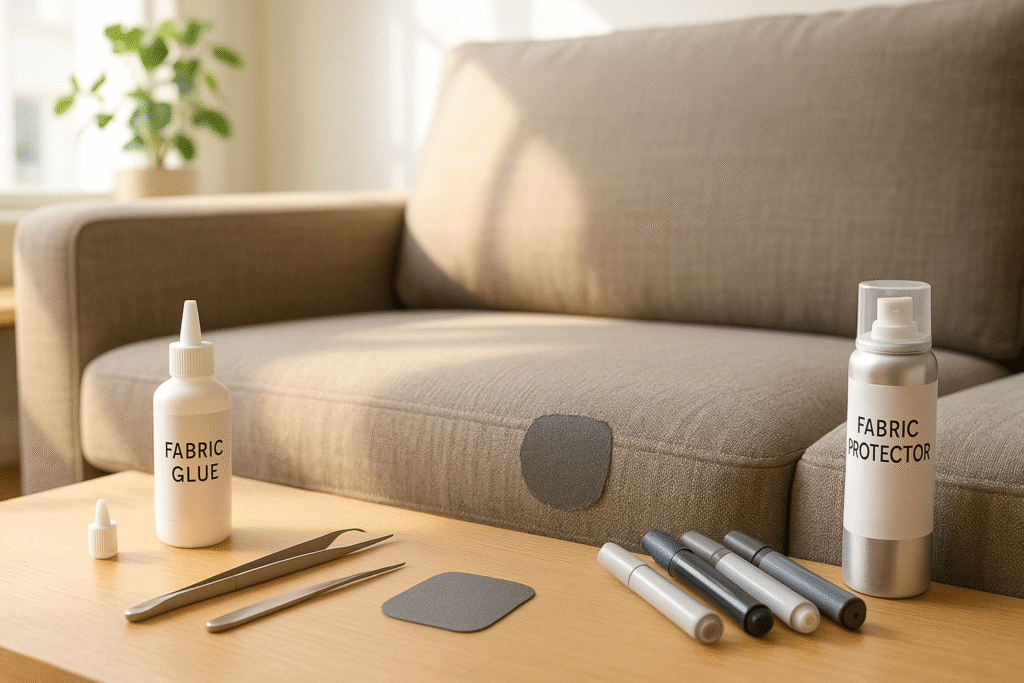
Frequently Asked Questions About Fix Burn Hole on Couch
When learning to fix burn hole on couch, many people run into similar questions about cost, durability, and technique. Addressing these FAQs can help you feel more confident before starting your repair. Below are some of the most common inquiries, along with expert-backed answers to guide your process.
Can I repair a burn hole without a patch?
Yes, smaller burn holes can often be fixed using fabric filler or adhesive alone. If the damage is less than the size of a pea, filler compounds can create a smooth surface without requiring a fabric swatch. However, for larger or deeper holes, a patch is usually necessary to restore strength and appearance. If in doubt, start small with filler and upgrade to a patch if the repair doesn’t hold.
How much does it cost to fix a burn hole on a couch?
DIY repair kits typically range between $10 and $30, making them an affordable alternative to professional services. Hiring an upholsterer to fix burn hole on couch can cost anywhere from $50 to several hundred dollars, depending on the fabric type, size of the damage, and labor involved. Slipcovers provide another budget-friendly option if multiple holes exist or if you prefer an instant solution.
Will the repair be noticeable?
The visibility of a repair depends largely on preparation and finishing. When done carefully—cleaning the area, trimming frayed fibers, applying adhesive evenly, and blending colors—the repair can be nearly invisible. For patterned or textured fabrics, the use of multiple dyes or pens makes blending even more effective. Skipping these steps, however, almost guarantees that the repair will be noticeable.
Can I use household glue instead of fabric adhesive?
It’s not recommended. Household glues often dry stiff, discolor fabrics, or fail to hold over time. Always use upholstery-specific adhesives or repair kits designed for fabric. For more detailed comparisons of adhesives, consult resources such as Consumer Reports, which provides unbiased product reviews and safety guidance.
How long will the repair last?
If completed with proper materials and allowed to dry fully, a repair can last for years. Adding protective sprays and avoiding direct heat sources further extends durability. Like all furniture care, ongoing maintenance is key—regular vacuuming, spot cleaning, and protective covers help prevent new damage and keep your couch looking fresh.
These FAQs highlight that with the right approach, anyone can successfully fix burn hole on couch. By following expert guidance and avoiding shortcuts, your couch can remain both functional and visually appealing for the long term.
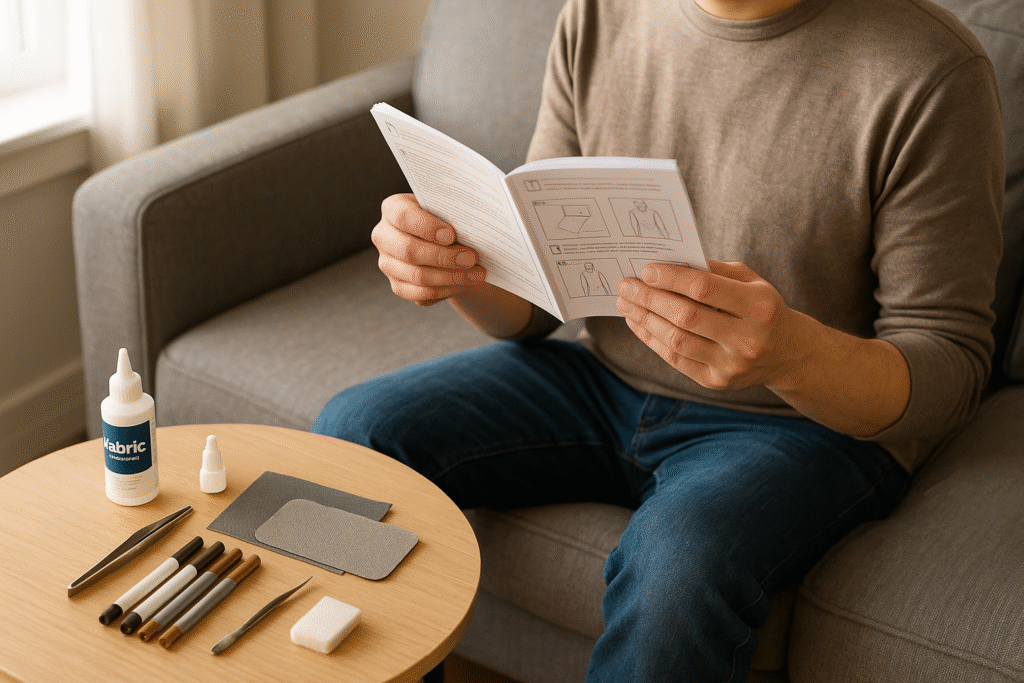
📌 Read Similar Topics
- The Ultimate Guide to Fix Burn Hole on Couch
- Unlock Efficiency: How to Unstick Stuck Shelf
- Replace Dishwasher Soap Holder Effectively
- 10 Best Ways to Fix Ripped Sneaker Like a Pro
- The Essential Guide to Cleaning Pilot Light
Conclusion: Putting It All Together
Learning how to fix burn hole on couch might seem intimidating at first, but as this guide demonstrates, it’s a process anyone can master with the right preparation, tools, and patience. From inspecting and preparing the damaged area to applying patches or fillers and carefully blending the repair, each step contributes to restoring your couch’s appearance and functionality. Along the way, we’ve also highlighted common mistakes to avoid, alternative methods you can consider, and expert practices that ensure your repair lasts as long as possible. By following this structured approach, you not only save money but also prolong the life of your furniture while reducing waste—a win for both your home and the environment.
The key takeaway is that no single solution works for every situation. Smaller burns may respond well to fillers alone, while larger or deeper holes often need patches or even professional attention. Alternatives such as slipcovers, embroidery, or liquid leather kits provide additional options, giving you flexibility depending on your couch type and personal preferences. Whatever method you choose, remember that preparation and patience are your best allies. Cutting corners or skipping crucial steps often leads to results that don’t hold up over time.
Incorporating these techniques empowers you to fix burn hole on couch with confidence, transforming what might have felt like a ruined piece of furniture into something refreshed and stylish once more. Beyond the practical benefits, there’s a sense of satisfaction in knowing you restored your couch with your own hands. The repaired piece will continue to serve as the centerpiece of your living space, offering comfort and aesthetic appeal for years to come. With this knowledge in hand, you’re ready to take on the challenge and ensure your couch remains as welcoming and functional as the day you first brought it home.

Share this:
- Click to share on Facebook (Opens in new window) Facebook
- Click to share on X (Opens in new window) X
- Click to share on LinkedIn (Opens in new window) LinkedIn
- Click to share on Reddit (Opens in new window) Reddit
- Click to share on X (Opens in new window) X
- Click to share on Threads (Opens in new window) Threads
- Click to share on WhatsApp (Opens in new window) WhatsApp

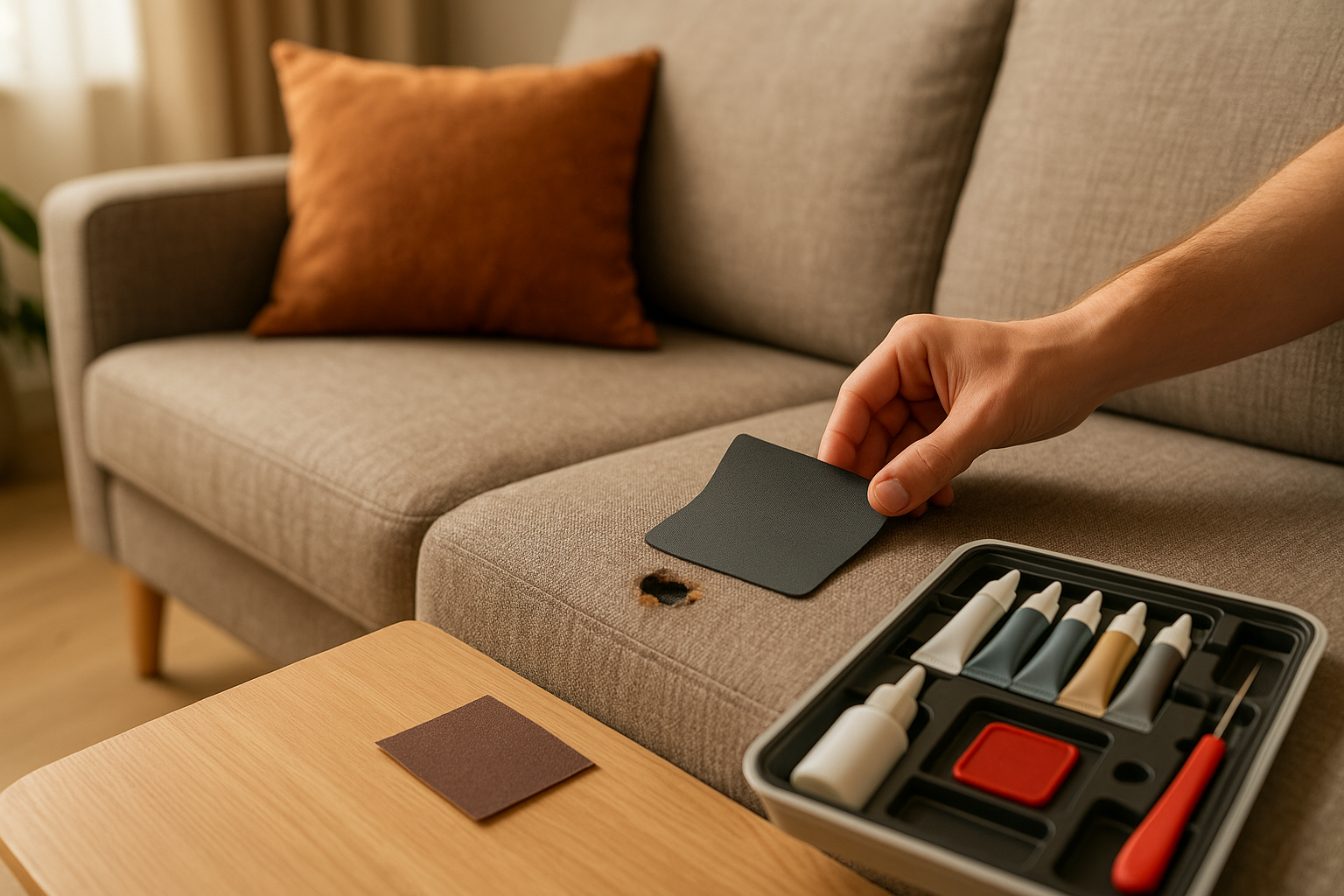



Pingback: Marble Scratch Repair With Simple Powerful Methods
Pingback: Edit Blurry Photos Easily With Powerful Fixes
Pingback: Fix Cigarette Burn In Headliner Fast With Proven Tricks
Pingback: How To Fix An Uneven Zipper Easily With Smart Hacks
Pingback: How To Fix A Scratched Wii Disc: An Ultimate Guide
Pingback: How Do You Make A Post Shareable On Facebook? (Simple Powerful Guide)
Pingback: Stripped Screw Hole Fix – Proven Powerful Repair Guide
Pingback: How To Check Oil Levels Easily: Essential Guide For Beginners
Pingback: How To Check Tire Pressure – Simple Guide For Safe Driving
Pingback: How To Check Coolant Levels Safely – Essential Car Care Guide
Pingback: How To Check Brake Pads Safely: Expert Tips That Work
Pingback: 7 Proven Tips On How To Cook A Lobster Like A Pro